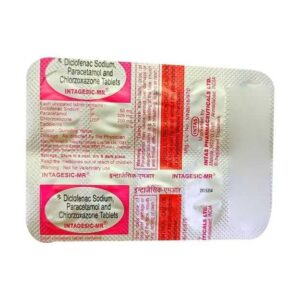ACECLOFENAC + PARACITAMOL + THIOCOLCHICOSIDE
Aceclofenac: Aceclofenac is a nonsteroidal anti-inflammatory drug (NSAID) that is used for the management of various painful and inflammatory conditions. It is commonly prescribed to treat conditions like osteoarthritis, rheumatoid arthritis, ankylosing spondylitis, and acute gout.
The mechanism of action of Aceclofenac is similar to other NSAIDs. It works by inhibiting the production of prostaglandins, which are responsible for pain, inflammation, and swelling. By reducing prostaglandin levels, Aceclofenac helps alleviate pain and inflammation associated with various conditions.
The recommended dose of Aceclofenac usually depends on the severity of the condition being treated and the individual’s response to the medication. However, the typical adult dose ranges from 100 to 200 mg once daily. It is generally recommended to take the medication with food to minimize the risk of stomach upset. The duration of treatment can vary depending on the condition, but it is usually prescribed for a short duration of time.
As with any medication, Aceclofenac can have certain side effects. Commonly reported side effects include gastrointestinal issues such as stomach upset, nausea, vomiting, diarrhea, and heartburn. Less commonly, it may cause headache, dizziness, skin rashes, and fluid retention. In rare cases, Aceclofenac can cause more serious side effects such as liver or kidney problems, allergic reactions, and gastrointestinal bleeding. It is important to seek medical attention if any severe or persistent side effects occur.
As with any NSAID, Aceclofenac should be used with caution in individuals with a history of gastrointestinal ulcers, liver or kidney disease, heart conditions, or bleeding disorders. It is also not recommended for use during pregnancy, especially in the third trimester, as it may harm the baby or cause complications during delivery.
It is essential to follow the prescribed dosage and duration of treatment and to consult with a healthcare professional before starting or stopping Aceclofenac. They will be able to guide you on the appropriate use of the medication, monitor your response, and manage any potential side effects or interactions with other medications.
Paracitamol: Sure, I think you meant “Paracetamol” also known as “Acetaminophen.”
Paracetamol is a commonly used over-the-counter medication and mild analgesic (pain reliever) and antipyretic (fever reducer). It is used to alleviate mild to moderate pain, such as headaches, toothaches, muscle aches, and pain associated with colds and flu. It is also used to reduce fever.
The exact mechanism of action of paracetamol is not fully understood. It is believed to work by inhibiting the synthesis of certain chemicals called prostaglandins, which are responsible for inducing pain and fever in the body. Unlike nonsteroidal anti-inflammatory drugs (NSAIDs), paracetamol does not have significant anti-inflammatory effects.
The recommended adult dose of paracetamol is typically 500 mg to 1000 mg every 4 to 6 hours, not exceeding 4,000 mg per day. Dosage may vary depending on age, weight, and medical condition, so it is important to follow the instructions provided by your healthcare professional or the packaging.
Paracetamol is generally well-tolerated when used at recommended doses, but it is important to be cautious and follow the recommended dosage to avoid potential side effects. Some common side effects may include nausea, stomach upset, and rash. In rare cases, paracetamol can cause liver damage when taken in excessive doses or when combined with alcohol, so it is important to avoid consuming alcohol when taking this medication.
It is essential to consult with a healthcare professional before taking paracetamol, especially if you have liver disease, alcoholism, or any other underlying medical conditions. It is also important to read and follow the instructions and warnings provided with the medication.
Thiocolchicoside: Thiocolchicoside is a muscle relaxant drug primarily used to relieve muscle spasms and stiffness. It is commonly prescribed for conditions such as acute muscle injuries, sprains, strains, and musculoskeletal pain.
The mechanism of action of thiocolchicoside involves its ability to enhance the release of gamma-aminobutyric acid (GABA), which is an inhibitory neurotransmitter in the central nervous system. This leads to decreased motor neuron activity, resulting in muscle relaxation and reduction in spasms.
The usual recommended dose of thiocolchicoside is 8-16 mg taken orally, two to three times a day. It can also be administered as a gel or cream and applied topically to the affected area. The dose and duration of treatment may vary depending on the individual and the specific condition being treated. It is important to follow the dosage instructions provided by your healthcare professional.
Common side effects of thiocolchicoside may include drowsiness, dizziness, headache, dry mouth, gastrointestinal disturbances (such as nausea, vomiting, and diarrhea), and allergic reactions. These side effects are usually mild and temporary. However, if you experience any severe side effects or have concerns, it is important to consult your doctor.
It is worth noting that thiocolchicoside should be used with caution in individuals with a history of liver or kidney problems, as well as those with a known allergy to the drug. Pregnant and breastfeeding women should also consult their healthcare provider before using thiocolchicoside.
As with any medication, it is important to follow the instructions provided by your healthcare professional and only use thiocolchicoside as prescribed. If you have any questions or concerns about this drug or its potential side effects, it is best to consult your doctor for further clarification.

